Re Ian Bremmer 'Could third-party candidates upend the 2024 US election?' 3 April The current political movement in the USA…
Natural Disasters 2010-2013
Written by Diana Thebaud Nicholson // December 23, 2013 // Natural Disasters // 1 Comment
Megastorm Aftermath The Passionate Eye In October 2012, Megastorm Sandy cut a path of devastation across the Caribbean and the East Coast, killing hundreds and doing tens of billions of dollars in damage. To many, it was a wake-up call. Now, one year after Sandy’s deadly strike, Megastorm Aftermath offers a fresh investigation of the critical questions raised by this historic storm: Was Megastorm Sandy a freak combination of weather systems? Or are hurricanes increasing in intensity due to a changing climate? What can we do to prepare ourselves for the next Sandy, and what progress has been made toward making our urban infrastructure more resilient? Much of Sandy’s wrecking power was due to an extreme storm surge that left large swaths of New York and New Jersey underwater. And with seas levels on the rise, flooding will only become more frequent. Megastorm Aftermath examines the role of climate change in driving these rising seas and looks at some of the latest extraordinary engineering employed in other areas, as well as what it may take to make cities like New York more resilient in the future. Written, Produced and Directed by Miles O’Brien for WGBH (PBS)
Hundreds of thousands without power after ice storm wallops Eastern Canada
The mayor of Toronto said “things are improving” in the city hit hard by a weekend ice storm which wreaked havoc from southwestern Ontario to the Atlantic Coast.
Rob Ford says power has been restored to 75,000 homes and more are being brought back every hour by Toronto Hydro crews working around the clock after ice splintered a huge number of trees and made roads and sidewalks treacherous.
He told a Monday morning news conference that approximately 200,000 customers still have no electricity but high winds that could have brought down more trees branches and caused more outages did not batter the city overnight as feared. Winter’s start ices eastern Canada, northeastern US before holiday; worst appears over
6 December
UK weather: More surge tides forecast after thousands evacuated along east coast
Thousands of people were evacuated from their homes along the east coast of England overnight to avoid what was feared could have been the biggest tidal surge for more than 60 years.
Violent storms batter UK triggering emergency response
Coastal communities face flooding threat after day of deaths, injuries, destruction and travel chaos
13 November
How the Philippines can ensure the best use of relief funds
Relief funding is flowing into the Philippines following Super Typhoon Haiyan, and the country needs to make sure that the aid isn’t wasted, writes Lean Alfred Santos. Previous disasters show that a coordinated response followed by good governance and sustainability actions will help get aid distributed efficiently, Santos argues in What the Philippines can learn from Haiti, 2004 tsunami
12 November
Climate Research: Lessons from Typhoon ‘Haiyan’
Many at the climate conference in Warsaw and around the world see a link between global warming and the devastating typhoon in the Philippines. But several studies point to other causes — and even more worrisome trends.
(Spiegel) Can the deadly typhoon really be attributed to man-made climate change? Statistics reveal other causal connections. For example, the way in which houses, dikes and settlements are built plays a decisive role in determining how many people will be hurt by a storm. In the United States, this has led to a steady decrease in hurricane-related deaths since 1900 despite significant rises in both the population densities and storm frequencies in at-risk areas. For Haiti, there are studies claiming that “urbanization in and migration into storm hazard prone areas could be considered as one of the major driving forces of (its) fragility” when affected by storms.
UN seeks aid funding for the Philippines; Valerie Amos to oversee relief effort
The United Nations has released $25 million in emergency aid for Philippines disaster relief and is appealing for a total of $301 million to assist the typhoon-stricken country. Valerie Amos, head of the Office for the Coordination of Humanitarian Affairs, will be on-site to oversee the UN’s relief efforts. Other countries have separately offered about $35 million in aid. BBC (11/12), The New York Times (tiered subscription model) (11/11), Voice of America (11/12), The New York Times (tiered subscription model) (11/12)
11 November
Rescuers Race to Philippines as Typhoon Death Toll Climbs
(Bloomberg) Rescue workers from Japan to Singapore are rushing to the Philippines after the year’s most powerful typhoon flattened buildings and unleashed storm surges that may have killed as many as 10,000 people, and as a new storm approaches.
Japan and Singapore are among countries sending in relief teams, while the Australian government announced A$10 million ($9.4 million) in assistance and China Foreign Ministry spokesman Qin Gang said the government and local Red Cross will collectively donate $200,000. The Philippine government warned the devastation may adversely impact the economy and sent in police and soldiers to prevent looting as survivors searched for food.
Philippines battle to move storm aid
(BBC) The authorities in the Philippines are struggling to bring relief to some of the areas worst affected by Typhoon Haiyan, one of the deadliest storms ever to hit the country.
Up to 10,000 are said to have died in Tacloban city and hundreds elsewhere. Hundreds of thousands are displaced.
The typhoon flattened homes, schools and an airport in Tacloban.
Relief workers are yet to reach some towns and villages cut off since the storm.
In many areas there is no clean water, no electricity and very little food. (Photos) More from Reuters
7 November
Typhoon Haiyan hits the Philippines with near-200 mph winds
One of the strongest storms ever recorded is closing in on the Philippines.
(PBS Newshour) Typhoon Haiyan is due to hit the eastern coast of the country Friday. The super storm has hit the maximum strength of 8.0 on the Dvorak scale with reports from the Joint Typhoon Warning Center of sustained 190 mph winds and also threatens to bring with it a storm surge of around 10 feet, easily threatening catastrophic damage to the country.
Philippines authorities have ordered evacuations and thousands have fled the central villages ahead of the typhoon.
27 October
St Jude’s Day storm: Four confirmed dead as Britain is bombarded with high winds and heavy rain
(The Independent) At it’s [sic] peak a total of 600,000 homes were left without power as a result of the storm
11 October
Cyclone Phailin Threatens Tens Of Thousands In Eastern India
(AP) — Officials ordered tens of thousands of coastal villagers to flee their homes Friday as a massive cyclone — so large it filled nearly the entire Bay of Bengal — gathered strength and headed toward India’s eastern seaboard.
Officials cancelled holy day celebrations and stockpiled emergencies supplies in coastal Orissa and Andhra Pradesh states, with forecasters saying Cyclone Phailin will hit the region Saturday evening.
The Indian Meteorological Department warned that Phailin was a “very severe cyclonic storm” that was expected to hit with maximum sustained winds of 210-220 kph (130-135 mph). If the storm continues on its current path without weakening, it is expected to cause large-scale power and communications outages, and shut down road and rail links, officials say. There would also be extensive damage to crops.
Premiers discuss disaster mitigation in wake of Alberta floods and Lac-Mégantic
Canada needs a new building program to protect the country from natural disasters, premiers said, as well as tough new measures to make sure shipments of dangerous goods are safe.
In the wake of once-in-a-century flooding in Alberta and the deadly derailment of an oil-filled train in Quebec, the Council of the Federation on Friday said the country must act immediately to ensure such catastrophes do not happen again. The provinces outlined several proposals they are willing to implement if the federal government will help. (26 July)
2011: A year of climate disasters
(Spiegel) Natural Disasters Related articles, background features and opinions
Extraordinary video of the tsunami in Japan and another Japanese Tsunami Viewed From A Car
Winds of Change — From the failed Mongol invasion of Japan to Cyclone Nargis, six storms that changed the course of history.
If Sandy swings this election one way or the other, it wouldn’t be the first time bad weather proved historically decisive. From the French Revolution to the 1971 Bangladesh Liberation War, meteorological events have made all the difference. Here’s a list of six storms that altered the course of history.
++++++++++++++++++
25 July
‘Rivers’ in air could boost flooding
(BBC) Winter floods could intensify in Britain, according to new research into powerful weather systems called “atmospheric rivers”. Only identified about 20 years ago, atmospheric rivers are intense bands of moisture that flow through the air. Known to be responsible for heavy rainfall, they have been blamed for severe flooding in California and the UK.The new study suggests that warmer conditions could create more rivers – and make them more severe. The paper is published by the Institute of Physics in Environmental Research Letters.
19 July
Governments ponder how to weather the next big storm
(Globe & Mail) First comes the deluge. Then the scramble to clean up. And then the hope that a flood-ravaged community won’t see a so-called “once-in-100-years” disaster for another century.
But with scientists, urban planners and insurers warning that freak flooding events that wreaked havoc on communities in Southern Alberta and around Toronto this summer will only grow more common with climate change, municipalities are now beginning to take the expensive, prolonged and sometimes politically unpopular steps to build up ambitious flood prevention infrastructure. … Following the release of an Alberta government plan for compensation and flood mitigation measures, Calgary Mayor Naheed Nenshi expressed concern that municipalities were not consulted, that the province’s flood maps may be out of date and that it’s not clear what next steps homeowners must take. [Related: How to keep Toronto’s storm sewers from flooding? Bring the rivers back]
15 July
India floods: More than 5,700 people ‘presumed dead’
(BBC) The government in the northern Indian state of Uttarakhand has said that more than 5,700 people missing after last month’s devastating floods will now be presumed dead.
Their families will be given financial compensation.
Earlier, authorities had confirmed that some 600 people had died.
14 July
Disaster and Emergency Management a growing field of endeavour
(RCI) Ali Asgary [professor of Disaster and Emergency Planning at York University in Toronto] says there are many risks small communities face they are not prepared to deal with as the Lac Megantic train derailment and explosions have proved. But he says, as a society, we are also creating new situations that even the most developed and technologically advanced societies can’t deal with as the breakdown of the Fukushima Nuclear plant following the earthquake and subsequent tsunami in Japan has illustrated. Ali Asgary says in Canada, in most communities, information and advice on emergency preparedness and response, is available, from what to do before a flood to how to behave during one for example, but only 30 per cent of people consult these sources.
27 June
Are Humans Responsible for the Himalayan Tsunami?
(IPS) As the government scrambles to complete a haphazard rescue operation, environmentalists are taking a step back, pointing out that the disaster was not simply a freak natural hazard but a result of unbridled development in the Land of the Gods.
For years, a booming tourist industry, made possible by thousands of illegally constructed guesthouses, has spawned massive hydroelectric power projects on the rivers, while other infrastructure development designed to accommodate hoards of visitors has proceeded at a steady clip, putting undue stress on this fragile ecological zone.
Scientists also say the damming of the Ganga, riverbed encroachment and mining activities are wreaking havoc on the region.
26 June
Toronto’s World Conference on Disaster Management
(RCI) It seems ironically relevant that the World Conference on Disaster Management is taking place in Canada during one of the worst flooding disasters in this country, across the western prairies.
With deadly flash floods having just occurred also in northern India, the worst in 80 years, and previous disasters like the huge storm damage along the New Jersey shore, and New Orleans in the USA, the tsunami in Japan, massive fires across Australia, and extreme droughts in Russia and Argentina, and more, not to mention man-made disasters like terror attacks, the issues surrounding dealing with disasters are becoming more urgent.
Adrian Gordon chairs the World Conference on Disaster Management, a four-day annual event which ends today [26 June] in Toronto, Ontario.
Dreadful as the Alberta floods are, their effects pale in comparison to what is happening in India
India floods: Rescue efforts intensify, as death toll rises
(BBC) Efforts have intensified in northern India to rescue tens of thousands of people trapped by flash floods that have already killed nearly 600 people.
The army is evacuating survivors in mountainous Uttarakhand state by helicopter and special trains are carrying people from affected areas.
More than 40,000 people are still stranded in what the government has described as a “national crisis”. … Early monsoon rains in India this year are believed to be the heaviest in 60 years.
Meanwhile in Calgary
Canadian Press reports: Much of Calgary remained soaked by floodwater Saturday morning, but there was some good news — the sun was out, rivers were receding and at least some evacuees were being allowed to return home.
Still, flood officials were warning that nothing would happen quickly and they were urging displaced people to stay away from their neighbourhoods until the city said it was safe.
20 June
Calgary flooding evacuation orders expanded
Calgary officials expanded evacuation orders and opened more emergency shelters Thursday night amid concerns about rising water levels. The evacuation orders have grown to cover nearly 20 neighbourhoods, and up to 100,000 people could be affected.
Calgary is dealing with swollen riverbanks and city officials are worried it could worsen. Meanwhile, thousands of people in southern Alberta communities like Canmore and High River have also been forced out of their homes by raging water. HuffPost photos and videos
15 June
EUROPE: Floods Are Here to Stay
IPS) – Record floods in Central and Eastern Europe have highlighted some of the challenges of climate change for the continent, as well as the floods’ potential to spur populist politics.
An extraordinarily long winter followed by weeks of intense rains has saturated soils and caused large rivers, such as the Danube and the Elbe, to overflow. The floods have wreaked havoc in the region, killing 21 people and forcing the evacuation of several tens of thousands.
21 May
Whole neighborhoods razed by Oklahoma tornado that killed 24
(Reuters) More than 24 hours after the tornado ripped through the Oklahoma City region with winds exceeding 200 miles per hour, emergency workers had pulled more than 100 survivors from the rubble of homes, schools and a hospital. About 240 people were injured.
16 April
Quake in Iran claims lives in Pakistan
(Al Jazeera) Cities in the Gulf and South Asia shaken as magnitude 7.8 earthquake strikes Iranian province adjoining Pakistan border. … “The earthquake was so powerful that it was felt in the southern city of Karachi, even damaging a few buildings in the country’s commercial hub.” … The earthquake also shook buildings in Abu Dhabi and Dubai, across the waters of the Gulf in the United Arab Emirates.
It was also felt in the Saudi capital Riyadh and in Oman. In the tourist hub of Dubai, residential and office buildings were evacuated and thousands of people gathered outside skyscrapers. More on BBC
8 April
Sinkhole Science is Actually Quite Simple
The drama of sinkholes, in which the earth can suddenly collapse and swallow up houses, has captured the popular imagination recently, but the science is actually as simple as water and rock.
(PBS) What causes a sinkhole?
Similar to other geological phenomenon like earthquakes, sinkholes tend to occur in specific geographic locations, but are almost impossible to predict. Sinkholes almost always form in a type of geological formation called “karst terrain”, which the United States Geological Survey says covers about 20 percent of the country.
Karst terrain occurs when “carbonate stone,” such as limestone, is dissolved by acid rain or changing ground water levels.
Rocks may seem hard and dry, impenetrable and unchanging, but porous stone is actually an important part of the Earth’s drainage system. When acid water passes through these stones, or when waterways change their course or volume of water, it can cause the stone to weaken from within.
Once the stone is sufficiently weak, it collapses to fill the area below, leaving a gaping surface hole. Because it is nearly impossible to detect weakened stone without high-tech geological monitoring equipment, sinkholes often occur spontaneously.
Sinkholes: Where will they strike next?
(Toronto Star) Sinkholes can happen anywhere, anytime — and they’re not as rare as you might think.
What are they?
Sinkholes are voids or disruptions beneath the earth that, for various reasons, lead to a collapse of the surface material. The more intense and unstable the cavity or hole underground, the greater the chance there will be a sinkhole.
They can range from shallow to deep, from coin-sized holes to gaping chasms that are larger than several football fields.
Why do they happen?
The formation of sinkholes is often closely tied to a type of terrain called karst — areas with limestone or other soluble rock like gypsum or salt. Because water flows through these rocks over long periods of time, it eventually dissolves them and creates voids, Doctor said.
A sinkhole’s development is strongly related to changes in the water underground.
7 April
US suddenly looks like a sinkhole nation (video)
Reports of a new sinkhole come each week. NBC’s Gabe Gutierrez examines the sinkhole epidemic.
UNDP: Mobile services save lives
A recent United Nations Development Programme conference focused on how mobile phones can become lifesaving technology during natural disasters, writes Bernadine Racoma. Disaster-prone countries can utilize mobile services to share information quickly and reduce human casualties. DayNews.com (4/7)
When it comes to weather, expect the unexpected
Weather extremes throughout the world are waking people up to the fact that weather is becoming even less predictable, according to this analysis. “[C]limate change is not just about rising temperatures, but also about intense, unpleasant, anomalous weather of all kinds,” writes Sarah Lyall. The New York Times (tiered subscription model) (1/10)
2012
Nigerian floods displace millions
Nigeria’s worst flooding in 50 years has left millions hungry, homeless and facing the threat of waterborne diseases. Meanwhile, the country’s infrastructure has suffered severe damage. The Nigerian government, United Nations and organizations such as Oxfam are trying to secure funding and coordinate a countrywide emergency response in such areas as public health, sanitation, water and food security. IRINNews.org (11/9)
8 November
Over four inches of snow covers the ground and flowers in Central Park after a nor’easter struck New York
(Planet Ark) A nor’easter Wednesday in New York and New Jersey knocked power out for hundreds of thousands of people and slowed utilities’ efforts to restore service to more than 600,000 still without power in the wake of superstorm Sandy.
2 November
Hurricane Sandy, Act II: The Fallout Puts Government (and Bloomberg) on Trial
The next few days in the Hurricane Sandy disaster zones decide Mayor Mike Bloomberg’s legacy and change the debate on government effectiveness
(The Atlantic) Five days away from a presidential election that centers on the role of government, Hurricane Sandy has handed the United States an extraordinary experiment in how government performs. In an impossible-to-imagine sequence of events, the city with the country’s largest police force, biggest fire department and highest tax revenues is being put to a historic test.
The political stakes are enormous. As the media blankets the rest of the country with saturation coverage of the recovery effort, an effective government response in New York and New Jersey could aid President Barack Obama in a deadlocked election. Looting, lawlessness and anger at government could aid Mitt Romney.
Thus far, Mayor Mike Bloomberg and his government are generally receiving high marks from city residents. But over the next several days events in the New York area could prove pivotal.
In a dozen interviews across the city Thursday, residents expressed growing worry. Promised aid from the Federal Emergency Management Agency was not arriving, fights were breaking out, and tensions simmered in gas lines that snaked for miles.
Cory Booker, Newark, New Jersey Mayor, Invites Hurricane Sandy Victims To His House
In the storm’s aftermath, the Newark mayor has been tweeting non-stop, offering updates on power outages, calming frazzled constituents and checking up on those in need.
And now he’s inviting neighbors without power to seek refuge at his house.
30 October
After the Floods
(Foreign Policy) Hurricane Sandy was devastating by any measure, but beleaguered New Yorkers can take comfort: It could have been worse. … a look at some of the world’s most devastating storms this year, often in places far less equipped to handle severe weather.
29 October
Sandy leaves NYC dark and deluged
(CBS) Much of New York was plunged into darkness Monday by a superstorm that overflowed the city’s historic waterfront, flooded the financial district and subway tunnels and cut power to nearly a million people.
The city had shut its mass transit system, schools, the stock exchange and Broadway and ordered hundreds of thousands of New Yorkers to leave home to get out of the way of the superstorm Sandy as it zeroed in on the nation’s largest city. Residents spent much of the day trying to salvage normal routines, jogging and snapping pictures of the water while officials warned the worst of the storm had not hit.
By evening, a record 13-foot storm surge was threatening Manhattan’s southern tip, utilities darkened parts of downtown Manhattan on purpose to avoid storm damage and water started lapping over the seawall in Battery Park City, flooded rail yards and parts of the financial district.
Countdown to ‘Frankenstorm’ Sandy: 1,000-mile wide hurricane hits 85mph as New York state braces itself for ’11ft wall of water’
(Daily Mail) Up to 2,500 holidaymakers could be left stranded in New York City as state and many other areas come to standstill More than 7,000 flights cancelled globally as Philadelphia and Newark airports each have more than 1,200 cancellations
28 October
Sharp Warnings as Hurricane Churns In
(NYT) Hurricane Sandy, a menacing monster of a storm that forecasters said would bring “life-threatening” flooding, churned toward some of the nation’s most densely populated areas on Sunday, prompting widespread evacuations and the shutdown of the New York City transit system.
Hawaii tsunami warning issued after Canada earthquake
Tsunami warning issued for Hawaii after a 7.7 magnitude quake struck off the coast of Canada’s British Columbia province
18 October
UK’s year of drought and flooding unprecedented, experts say
(The Guardian) The scale of drought recovery in 2012 has ‘not been seen before’, says Centre for Ecology & Hydrology
The dramatic switch from drought and hosepipe bans in England this spring to the wettest April to June ever and widespread flooding was of a magnitude never seen before, water experts said on Thursday.
While water supplies have made “dramatic” recoveries from droughts before, such as in 1975-76, “sustained recoveries of this magnitude during the late spring and summer have not been seen before,” said Terry Marsh, from the Centre for Ecology & Hydrology (CEH).
24 August
The U.S. drought, freak occurrence or a changing climate?
(CBC) The weather conditions that led to this summer’s unusually hot weather in the belly of the continent forebode potentially far more dangerous climatic consequences down the road, climatologists are saying.
And if history is any kind of teacher, droughts and their resulting impact on the food chain are also important triggers of social unrest.
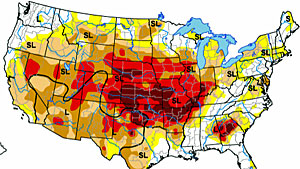 The U.S. Federal Department of Agriculture Drought Map for Aug. 21, 2012. The coloured areas range from abnormally dry (yellow) to extreme and exceptional drought (red and dark brown).
The U.S. Federal Department of Agriculture Drought Map for Aug. 21, 2012. The coloured areas range from abnormally dry (yellow) to extreme and exceptional drought (red and dark brown).
4 March
Tornado-stricken towns sift through rubble
Dozens have died across a broad stretch of the Midwest and South. Those who rode it out recall the terror of the storm: ‘It was roaring…. It was so loud it’d make your ears hurt.’ Tornadoes rake Midwest, South; 3 die in hard-hit southern Indiana
A year after Japan’s tsunami, debris floats in Pacific
Up to 2 million tons of debris pulled into the seas after the Japanese tsunami a year ago are now dispersed halfway across the Pacific Ocean, according to scientists. Some of the debris — including lumber, construction material, refrigerators, TVs and fishing boats — will become ensnared in the Great Pacific Garbage Patch, while some will stop at remote atolls north of Hawaii and along the west coasts of Canada and the U.S. The Christian Science Monitor/The Associated Press (2/29), BBC (2/22)
10 January
Weather Chaos Strikes Europe Despite Mild Winter
(Spiegel) There has been a dearth of snow so far this winter, but storms this week have created havoc across much of northern Europe. On Thursday, lightening set a Bavarian church ablaze and dike leak warnings in the Netherlands have led to the evacuation of 800 residents.
2011
UN disaster-fund shortfall reflects unpreparedness
Wealthy countries are not paying enough into the UN’s Central Emergency Response Fund, which was designed by the world body to speed up relief in crisis zones. The situation leaves much of the world “dangerously unprepared” for future disasters, said Andrew Mitchell, the U.K.’s international-development secretary. Many countries are opting to wait for events to happen before offering money, said Mitchell, who noted an anticipated $70 million shortfall for 2012. The Guardian (London)/The Press Association (U.K.) (12/26), BBC (12/27)
UNDP report links global well-being to environment
Improvements in the living standards of the world’s poorest people are being hindered by environmental degradation and the effects of climate change, such as drought, storms, flooding and rising sea levels, according to a major report from the UN Development Program. Sustainability must become “how we choose to live our lives,” concludes the 2011 Human Development Report, which emphasizes that living conditions need not be fueled by consumption of more fossil fuels. The Guardian (London) (11/2), Reuters (11/2), The Washington Post/The Associated Press (11/2)
1 November
(CBC) Slave Lake wildfire becomes arson investigation
4,700-hectare fire in May caused $700M in damages
30 October
Bangkok Evacuates as Floodwaters Rise
Historically severe floods in the heart of Thailand have crept into Bangkok. A third of the nation stands underwater and the last decade of development has left the capital without natural defenses such as forests and grasslands. The country’s new prime minister is struggling to show a brave face.
29 October
(Planet Ark|Reuters) Peak tides tested Bangkok’s flood defenses The floods have killed at least 381 people since July and affected more than 2 million. Authorities have cut growth forecasts for Southeast Asia’s second biggest economy. Disruptions to auto and computer-part producers have been felt worldwide.
Water flowing down the central Chao Phraya river basin from the north is meeting peak tides surging in the Gulf of Thailand, 20 km (12 miles) south of Bangkok, leading to fears the city’s makeshift defenses would be swamped.
29 October
Turkey Earthquake 2011: Final Day Of Rescue Search
(HuffPost) The death toll in the 7.2-magnitude earthquake that also rattled parts of Iran and Armenia, increased to 582, of whom 455 were in the eastern city of Ercis. Close to 4,000 were injured and some 230 were brought out of the ruins alive, authorities said. (24 October) Turkey earthquake 2011: Rescuers dig through debris in hunt for survivors
Rescue is under way after Asia earthquake
Rescuers are battling rain and landslides in a battle reach those affected by the 6.9 magnitude earthquake that hit India, Nepal and Tibet on Sunday. Dozens have already been reported dead, and more than 100,000 homes were destroyed. BBC (9/19), Reuters (9/19), The Globe and Mail (Toronto)/The Associated Press (9/19)
8 September
Weather disasters keep costing U.S. billions this year
(Reuters) – Blizzards. Tornadoes. Floods. Record heat and drought, followed by wildfires.
The first eight months of 2011 have brought strange and destructive weather to the United States.
From the blizzard that dumped almost two feet of snow on Chicago, to killer tornadoes and heat waves in the south, to record flooding, to wildfires that have burned more than 1,000 homes in Texas in the last few days, Mother Nature has been in a vile and costly mood.
Climate experts point to global warming, meteorologists cite the influence of the La Nina weather phenomenon or natural variability and, in the case of tornadoes hitting populated areas, many simply call the death and destruction bad luck.
But given the variety and violence of both short-term weather events and longer-term effects like a Southwestern drought that has lasted years, more scientists say climate itself seems to be shifting and weather extremes will become more common.
29 August
Hurriquake! Mudslami! Volnado!
How often do natural disasters coincide?
(Slate) Virginia experienced its strongest earthquake in a century last Tuesday. Four days later, a major hurricane passed through. How often do those two natural disasters occur in quick succession?
All the time. Many regions that experience tropical cyclones are also seismically active. East Asia, Australia, Mexico, and the western Caribbean all lie in the Pacific Ring of Fire, a swath of earth that suffers from frequent and powerful quakes. Since earthquakes are so common in those areas—in the last week, events of magnitude four or greater were registered in Indonesia, Japan, Fiji, Vanuatu, Tonga, New Guinea, the Philippines, and Aruba—they often coincide with typhoons and hurricanes.
Category 5 hype: Did nonstop coverage of hurricane Irene save lives?
(CSM) Some media critics lashed out at what they saw as hysterical coverage of hurricane Irene in the media. But others say, when lives are at stake, hype isn’t a bad thing. (BBC) Death toll from Irene keeps rising — The number of people killed by Tropical Storm Irene nears 40, as authorities warn flooding could continue for three more days in some US states.
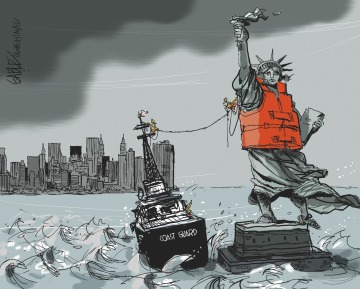
New York shutting down ahead of hurricane
(Reuters) – The city that never sleeps starting shutting down at midday Saturday with nearly all businesses except a smattering of food and liquor stores closing and public transportation coming to a halt ahead of Hurricane Irene.
With the 600-mile (1,000-km) wide storm moving up the U.S. East Coast unleashing winds of 85 miles per hour (140 km per hour) and due to hit New York City late Saturday or early Sunday, Mayor Michael Bloomberg ordered an unprecedented evacuation of 370,000 people in low-lying areas.
27 August
North Carolina Roads Flood, Lights Fail as Irene Weakens
(Bloomberg) Hurricane Irene swamped North Carolina’s Outer Banks, causing flooding in the eastern part of the state and knocking out power for more than 340,000 homes and businesses.
“She’s pounded the state all night, but fortunately –this is really good news for us — the force has not been the kind that was originally forecast,” Governor Bev Perdue said at a news conference in Raleigh.
Perdue said hurricane winds are expected to blow along the coast for the rest of the day as Irene continues up the Eastern Seaboard in a storm that forced evacuations in several states and is bringing transportation in the U.S. Northeast to a halt.
14 July
Brian Stewart: Drought in the Horn of Africa, does the world still care?
A humanitarian disaster in slow motion is threatening nearly 10 million people
(CBC) Already the landscape is streaked with long lines of dead cattle and their whitening bones. Across three nations, a pastoral population is losing its herds, its very life essence in many cases.
Farmers have had to consume seeds. Some food prices, such as for sorghum, a local staple, have soared 240 per cent. The main drought refugee camp in Kenya is exploding with close to 400,000 hungry people in a facility designed for 90,000. (BBC) Horn of Africa drought: Kenya to open Ifo II camp — Kenya has agreed to open a new refugee camp near its border with Somalia, as thousands of people flee the region’s worst drought in 60 years. (Toronto Star) East Africa drought ‘the most severe humanitarian emergency in the world’ (BBC) Horn of Africa drought: Why is Somalia worst affected? (The Telegraph) The forgotten people of Africa’s famine cry out for aid — It is a long walk from Fini village to Dadaab, the Kenyan refugee camp now the focus of attempts to save millions of people from starving to death in the Horn of Africa.
5 July
Natural disasters displaced 42 million in 2010
(CBC) About 42 million people were forced to flee their homes because of natural disasters around the world in 2010, more than double the number during the previous year, experts said Monday.
One reason for the increase in the figure could be climate change, and the international community should be doing more to contain it, the experts said.
The Internal Displacement Monitoring Centre said the increase from 17 million displaced people in 2009 was mainly due to the impact of “mega-disasters” such as the massive floods in China and Pakistan and the earthquakes in Chile and Haiti.
It said more than 90 per cent of the disaster displacements were caused by weather-related hazards such as floods and storms that were probably impacted by global warming, but it couldn’t say to what extent.
+++++++++++++
Dust storm descends on Arizona in US – Incredible pictures!
A big dust storm descended on the Phoenix area of Arizona on Tuesday, drastically reducing visibility and delaying flights.
The storm was part of the Arizona monsoon season, which typically starts in mid-June and lasts until the end of September.
Linking extreme weather to climate change
Climate scientists across the world have created a new alliance tasked with verifying links between extreme weather and climate change. The coalition, called the Attribution of Climate-Related Events, breaks with scientific tradition in that it could link a single extreme weather event — such as an intense hurricane, a major flood or a devastating drought — to global warming. The Independent (London) (7/1)
16 June
Torrential Rains Batter Parts Of China, Floods Spread
(Planet Ark) Pelting rain in parts of central and southern China has forced hundreds of thousands of people to leave their homes and prompted the government to demand safety checks on vulnerable dams, news reports said on Thursday.
The torrential rains have ended a drought in many areas, but now threaten the Yangtze River basin and nearby provinces with floods and mudslides that have killed at least 105 people.
6 June
China faces worst drought in 50 years
(FT) Monsoons that flood the middle Yangtze river did not arrive this year and officials say rainfall in Hubei, Jiangxi, Anhui, Jiangsu and Zhejiang is at its lowest level in more than 50 years
Icelandic Ash Cloud Reaches Norway and Denmark
(AP via ABC News) A dense ash cloud from an Icelandic volcano blew toward Scotland, causing airlines to cancel Tuesday flights, forcing President Barack Obama to shorten a visit to Ireland, and raising fears of a repeat of last year’s huge travel disruptions in Europe that stranded millions of passengers.
Recent natural disasters not isolated, but connected
Scholar and global climate activist Bill McKibben dares readers not to merely view recent U.S. and global natural disasters as isolated incidents, but direct consequences of climate change. He draws connections among disasters that appear to fly in the face of a recent filing by the U.S. Chamber of Commerce with the Environmental Protection Agency stating that “populations can acclimatize to warmer climates via a range of behavioral, physiological, and technological adaptations.” The Washington Post (5/23)
16 May
Wildfires force evacuations from Alberta oilsands
Conventional production also affected by northern blazes
(Calgary Herald) Forest fires in northern Alberta continued to rage out of control, forcing oil and gas producers to shut down operations as smoke and flames spread across the province.
Companies evacuated workers and closed heavy oil facilities, pipelines and processing plants in north-central and northeastern Alberta as emergency teams battled fires which had spread across more than 30,000 hectares by Monday, fuelled by strong winds over the weekend.
Slave Lake: A town hit by an inferno
Slave Lake woke up Sunday a bustling resource town; a nice place to raise a family and find a good paying job in the oil and gas or logging industry. By Monday morning she was a smoldering corpse reeking of charred timber and shattered dreams
(Edmonton Journal) Wildfire destroys Slave Lake’s city hall, library — One-third of the town is lost to ‘devastating’ fire: Mayor
Flooding Mississippi destroys home, carries alligators
(M&C) The raging Mississippi River continued to hold the US South in the grip of record-breaking floods on Monday as low-lying parts of Louisiana succumbed to the onslaught.
Officials reminded residents to stay clear of the edges of the flood to avoid dangerous animals unleashed by the floods. The Louisiana Department of Health and Hospitals has urged residents near the river to be ‘on the lookout for dangerous wildlife … such as snakes, rats, alligators or any frightened animal.’ Historic Vicksburg, Mississippi Faces Flood Siege
Dry weather helps contain deliberate Manitoba flood
(Reuters) The intentional breach was meant to ease pressure on stressed dikes so that worse, unplanned flooding from a dike failure could be avoided. But the controlled resulting flow of water onto farmland has been slower than the Manitoba government had planned.
Officials estimate the flood will cover up to 72 square miles (180 square km) of land over the next few days, down from the 90 square miles they had estimated on Saturday. Much of that is rich farmland that usually grows wheat and vegetables.
(Canadian Press) Floods in Manitoba, Quebec stir up longer-term environmental concerns
Drought Expands Dramatically in Texas, Losses Mount
(Claims Journal) Another dry week in the southern United States has driven the spread of a devastating drought further across Texas and neighboring states, promising to add to economic losses that could top $3 billion.
Texas, suffering its longest dry spell on record, saw the highest level of drought — dubbed “exceptional” by climatologists — jump from 26 percent of the state to 48 percent over the last week, a report released Thursday by a consortium of national climate experts said.
So far at least 9,000 wildfires have destroyed or damaged more than 400 homes and scorched 2.2 million acres (890,000 hectares) across Texas, according to state officials who have asked for federal assistance.
The region’s new wheat crop has largely withered as other crops being planted now thirst for moisture, while pastures and rangeland are so poor they cannot sustain grazing cattle.
14 May
MANITOBA DIKE BREACHED TO CONTROL FLOODING [See Catherine Gillbert comment below]
(RCI) Crews in the western province of Manitoba have breached a dike along the swollen Assiniboine River, starting a deliberate flood that will send water over a vast area where more than 150 homes are located. The move is intended to relieve pressure on the river and save hundreds of homes downstream. Premier Greg Selinger has said the decision to cut a hole in the dike was not an easy one and says the government is setting up a special compensation fund for home owners and businesses affected by the disaster. (National Post) Manitoba flooding process trickles on slowly In Quebec, there is also severe flooding, the worst in over a century. In St. Jean sur Richelieu, south of Montreal, some 800 people were forced from their homes. Although some have been allowed to return after water levels receded, there is concern of renewed flooding because of heavy rains that are forecast to fall all weekend.
Staring down a deluge, Manitoba calls flood-forecasting veteran out of retirement
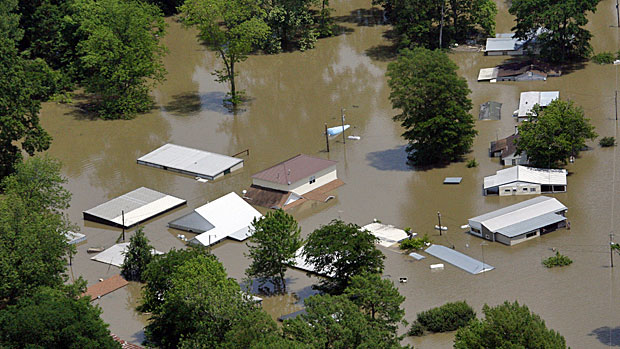
Rogelio V. Solis/Associated Press
Mississippi River Flooding Reaching Historic Levels
In one of the worst cases of flooding since the Great Depression, the bulging, swollen Mississippi River is overflowing in record proportions, blanketing thousands of square miles across Arkansas, Tennessee and Mississippi, negatively impacting the environment, and causing billions of dollars in damage.
While residents scramble to reach higher ground, the rest of the country has focused on the economic and environmental impacts of this last round of severe weather, which comes in the wake the devastating tornadoes that swept the Southeast two weeks ago.
The water is flooding some of the most fertile areas in the country, so damages to agriculture alone could easily top $2 billion, according to estimates by economist John Michael Riley, a professor in the department of agricultural economics at Mississippi State University. … The river is slowly spreading across millions of acres of farmlands that contain pesticides, fertilizers and other chemicals. The sheer amount of water is diluting the concentration of these toxic chemicals, but the Mississippi State Department of Health still note that the water could carry disease, especially tetanus.
8 May
Flood anxiety surges in Manitoba, ebbs in Quebec
(Globe & Mail) … In Quebec, a week of predicted warm weather should provide the flood-ravaged province with much-hoped-for respite, authorities say.
“Water levels are falling two to five centimetres a day and we expect this trend to continue until at least Friday,” Yves Leroux, director-general of Public Security for the Montérégie region, said in a press conference on Sunday afternoon in Vénise-sur-Québec.
He cautioned, however, that flooding remains widespread, particularly in the hardest hit areas around Lake Champlain and the Richelieu River and it could take a while before residents can return to their homes in regions where there were evacuations.
29 April
Tornadoes tear across South, killing over 300 – Obama visits tornado-hit South to back recovery
TUSCALOOSA, Alabama (Reuters) – Tornadoes and violent storms tore through seven Southern states, killing at least 306 people and causing billions of dollars of damage in one of the deadliest swarm of twisters in U.S. history.
28 March
Online mapping and humanitarian relief
Humanitarian relief efforts can be greatly enhanced by the deployment of crowdsourced mapping tools, according to a report, but more coordination is required by leading agencies including the UN and the Red Cross for them to reach their potential. The analysis comes from a report called “Disaster Relief 2.0: The Future of Information Sharing in Humanitarian Emergencies” from the UN Foundation, the UN Office for the Coordination of Humanitarian Affairs, the Vodafone Foundation and the Harvard Humanitarian Initiative. Click here to read and download the full report, via the UN Foundation. The New York Times (3/28)
Earthquake hits Myanmar
A 6.8 magnitude earthquake hit Myanmar near the Thailand border Thursday damaging homes, bridges and other infrastructure, and leaving at least one person dead. Myanmar authorities have released little information about damage estimates or plans for an official response. AlertNet/Reuters (3/24), TIME/Global Spin blog (3/24)
Crisis prompts new look at nuclear
The humanitarian crisis in Japan is being compounded by the threat posed by earthquake-damaged nuclear plants. In the United States, groups are re-evaluating the role of nuclear power should play in future domestic energy policy. Even staunch supporters of nuclear energy are calling for a delay in the licensing and construction of new reactors. The New York Times (3/13)
12 March
Japan’s Strict Building Codes Saved Lives
(NYT) Perhaps no country in the world is better prepared to withstand earthquakes and tsunamis than Japan.
Nicholas Kristof: Sympathy for Japan, and Admiration
Earthquake triggers tsunami in northeastern Japan
Thirty UN disaster assessment and coordination teams are poised to travel to Japan to assist rescue workers there after a devastating tsunami triggered by an 8.9-magnitude earthquake in the northeastern part of the country. No leaks have been reported at the 11 nuclear plants located in the earthquake zone, but the Japanese government declared a state of emergency at one plant after its cooling system failed. Reuters (3/11), The Guardian (London) (3/11), BBC (3/11)
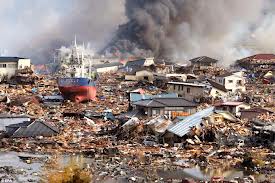 Japan Earthquake 2011: 8.9 Magnitude Earthquake Hits, 30-Foot Tsunami Triggered
Japan Earthquake 2011: 8.9 Magnitude Earthquake Hits, 30-Foot Tsunami Triggered
A ferocious tsunami spawned by one of the largest earthquakes ever recorded slammed Japan’s eastern coast Friday, killing hundreds of people as it swept away boats, cars and homes while widespread fires burned out of control.
Hours later, the tsunami hit Hawaii and warnings blanketed the Pacific, putting areas on alert as far away as South America, Canada, Alaska and the entire U.S. West Coast. In Japan, the area around a nuclear power plant in the northeast was evacuated after the reactor’s cooling system failed. Dozens of cities and villages along a 1,300-mile (2,100-kilometer) stretch of coastline were shaken by violent tremors that reached as far away as Tokyo, hundreds of miles (kilometers) from the epicenter. A large section of Kesennuma, a town of 70,000 people in Miyagi, burned furiously into the night with no apparent hope of the flames being extinguished, public broadcaster NHK said. Hawaii Tsunami Waves Sweep Across Islands
22 February
New Zealand Earthquake 2011: Christchurch In Ruins After 6.3-Magnitude Temblor
Tuesday’s temblor was the second major quake to hit Christchurch in five months, though it caused more damage than a considerably stronger September quake. Though rescue efforts are continuing, more than 100 people are thought to remain trapped in the rubble late Tuesday night. Some survivors have been able to send text messages or make phone calls from under the wreckage.
New Zealand Earthquake: Christchurch Cathedral Rubble Reveals 150-Year-Old Time Capsules
The discovery of two objects believed to be 150-year-old time capsules among the rubble of Christchurch Cathedral after New Zealand’s devastating 6.3-magnitude earthquake is being hailed as a miracle.
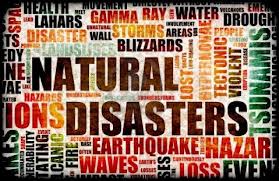

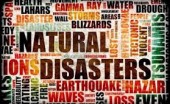
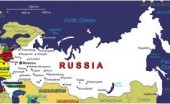

One Comment on "Natural Disasters 2010-2013"
What to me is much more interesting is the long term consequences of the climate change debate. I was at a conference in the mid ’70s and the keynote speaker was a Prof Harte geography U of T. This was the first time I had heard of the greenhouse effect and his position was that global warming was inevitable and humans will never willingly decrease their use of energy and we should start on planning for the consequences. He was concerned with flooding and water shortages on the prairies and the fact we will be able to grow grains further north with increased heat and increased CO2 levels. Had we started building the levees as he recommended 40 years ago there would be no need to flood valuable farm land [emphasis added]. The blame lies with government. Politicians are lawyers who like arguing rather than scientists who like facts. The green movement also has not helped by focussing too much on reducing use of fossil fuels – unacceptable to the majority especially in the developing world instead of advocating mitigation and investment in alternative energy.